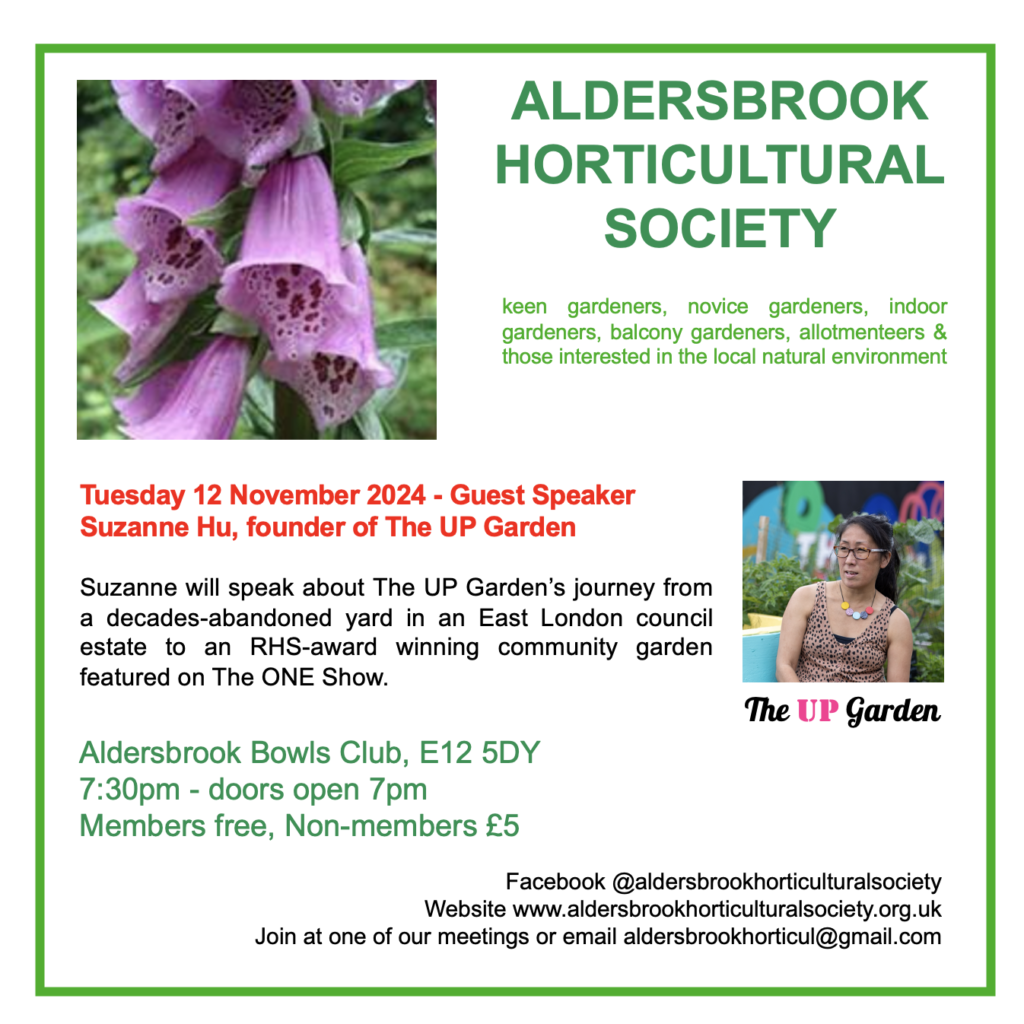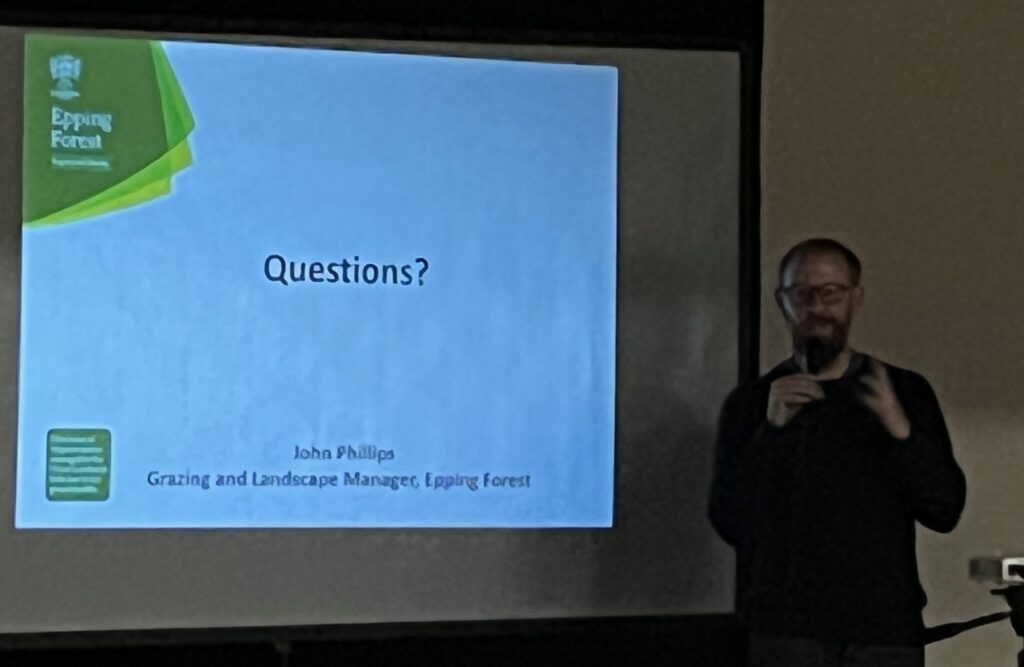






Members of Aldersbrook Horticultural Society were treated to a great talk last Tuesday 8th October, by John Phillips, the Head Conservator of Epping Forest about the cows in Epping Forest and how they are used to improve the landscape of the forest.
Epping Forest covers 3,600 hectares of land and was created by an Act of Parliament in 1878 and is owned by the City of London corporation. After the Forest was taken over by the corporation the ancient custom of pollarding tees was stopped which meant grassland did not grow as it had previously, reducing biodiversity and the space for cattle to graze. Until the middle of the 20th Century cattle grazed in all parts of the Forest, indeed many who were at Tuesday’s meeting can remember cattle walking through the roads of Aldersbrook between the Flats and the Park. Cattle were taken away from the Forest in 1996 as a result of the outbreak of BSE. From 1998 to 2002 cattle were brought back to the Forest, the Longhorn breed were chosen for their docility, with the aim of conservation of the grassland and to increase biodiversity.
Cattle are grazed in Epping Forest to conserve some of the ancient acid grassland, protect the grassland habitats and encourage a wider range of insects, such as dung beetles, to live in the Forest. John talked to us about the Forest’s farm at Theydon Bois where the cows are in calf are kept under cover for about three months.
He explained that it is now possible to have cattle grazing in Wanstead Park as a device the cows wear around their necks acts as an ‘electric fence’ as well as tracking where they are and even how many steps they have done!! The cows currently in the park are called Nina, Olive, Answer and Mara and they will be there until early next year.
There were many questions to John at the end of his talk including how they get their names (from members of the public), what happens to the males in the herd (they get sold to a breeder in Derbyshire); some beef from older cows is sold for ready meals to a well known supermarket, while beef from younger cattle is sold locally.
The talk was very well received and gave a fascinating insight into an important aspect of local life.
According to our October Newsletter, “It is impossible to rain more than it has in September…” so make the most of the weather when it allows us to spend time in our gardens. October is a mixed bag, with some days crisp and sunny, others all wind full of leaves and possibly an Indian summer might bring mild and warmer days.
Autumn can feel like a bit of a race in the garden. There are so many jobs that can be done, but as the days get shorter and the chill creeps in, the weather will dictate your schedule.
There is still just time to take semi-ripe cuttings of verbena, penstemon, salvia, hebe, choisya …Check out the September tips of the month for details on how to take cutting.
Fruit and vegetables
Pumpkins: support them on bricks or tiles so the sun can ripen them, improving their colour before you carve them on the 31st, or you can store for the winter. They will keep up to 6 months in a cool, dark place, at a temperature range of 10-16 degC. Store them in a single layer.
Sow broad beans: “Aquadulce” and “Meteor” are good for overwintering and a spring harvest. Sow them directly in the ground.
Plant autumn onions: choose autumn-planting variety such as “Radar” or “Electric”. Plant the sets into well-prepared, fertile soil. Onions need a lot of moisture. You shouldn’t have to water in winter but in spring and summer provide extra moisture if necessary.
Plant garlic: garlic is best planted in free-draining soil in late autumn or early winter, as the cloves need a period of cold weather to develop into bulbs. To protect the emerging bulbs from birds, lay netting over new plants.
Rhubarb: new crowns can be planted now and established clumps can be divided. Remember, splitting your rhubarb plants is essential for a lush harvest year after year.
Bare-root fruit trees: October/November is the ideal time to plant fruit trees. Choosing where to plant your tree and good soil preparation are vital. Choose a site in full sun with enough room for the branches to grow and develop over time.
Improving soil: add mulches, garden compost, spent pot compost and manure to bare soil patches. Soil preparation is vital when growing vegetables. The best time is in autumn for heavy soils and spring for light sandy soils. Digging well-rotted organic matter or manure into clay soil will improve the structure and make it easier to work.
Green-manure can also be used to cover bare patches between crops. An over-wintering green manure mixture sown in the autumn will help to smoother weeds and prevent soil erosion from winter rain. It will be ready to be dug up in spring releasing nutrients and improving the soil structure.
Flowers
Dahlias: with little care and attention dahlias will keep flowering for several weeks. Deadheading, keeping plants well staked and clearing up any fallen leaves and debris.
Spring-flowering bulbs: October is the best times to plant daffodil, crocus and iris bulbs, tulips can wait until November.
Bare-root shrubs, rose and peonies: plant them this month and enjoy their bloom in spring.
Herbaceous perennials: herbaceous perennials can become less productive over time and it’s best to divide the plants every 3 to 5 years. October is a good time to divide and move plants around or to share them with friends.
Mulch borders: as perennials die back cover any bare soil with a thick layer of mulch (about 5 cm deep). Leave gaps around woody plants to stop the mulch coming into contact with stems and causing rot.
Mulching will prevent erosion, protecting the soil from heavy winter rain. It will also help to suppress weeds and as it gradually breaks down, it will feed the soil and improve its structure.
Mulch could be anything from summer containers spent compost, well-rotted bark, homemade leaf mould or compost. If using spent compost from summer containers, check for vine weevil grubs before spreading on soil.
Alpines and succulents: alpines and some succulents will cope with winter temperatures, but they will suffer if their roots stay too damp for to long.
Make leaf mould. Leaf mould is produced naturally in woods and forests. It differs from conventional composting by the way it is decomposed. Composting uses bacteria to break down leaves while leaf mould uses fungi. It is also a very slow process that will take a minimum of 1 year to 2 or even 3 years depending on the type of leaves. It is an invaluable soil conditionner. Well-rotted (over 2 years old) it can be used as seed-sowing compost. Leaf mould that is less than 2 years old can be used as mulch and soil improver.
So start now and welcome autumn leaves as a gift to your garden, turning them into “black gold”.
You can also build a storage pen from chicken wire supported at the corner with stakes. Make you leaf heap as large as possible to hasten decay and sprinkle with water in dry spells.
Don’t forget